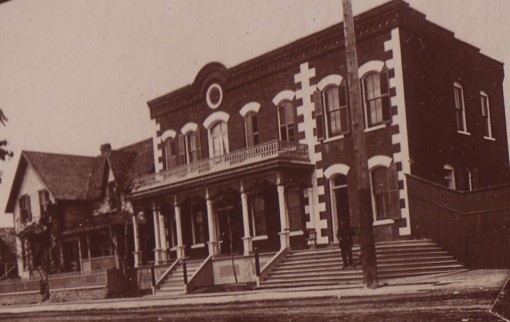More than 80 people gathered in Belleville’s Quinte Sports and Wellness Centre on Saturday for a day exploring historical aspects of European and First Nations attitudes to “the land that supports our feet”. The Warden of Hastings County (and Reeve of Tyendinaga Township), Rick Phillips; the Chief of the Mohawks of the Bay of Quinte, R. Donald Maracle; and the Mayor of Deseronto, Norman Clark, all gave official welcomes to the group.
 The traditional Six Nations Opening was performed by Nathan Brinklow, who provided an English translation of his words so that everyone could understand. As Nathan explained in his introduction, the Opening is all about the relationships between the land, waters and living things, so it was a particularly appropriate way of starting a day of proceedings focused on human interactions with land.
The traditional Six Nations Opening was performed by Nathan Brinklow, who provided an English translation of his words so that everyone could understand. As Nathan explained in his introduction, the Opening is all about the relationships between the land, waters and living things, so it was a particularly appropriate way of starting a day of proceedings focused on human interactions with land.
The keynote address was given by Marlene Brant Castellano, who gave a moving account of the way that her formal education in the Tyendinaga Mohawk Territory, Shannonville, and Belleville had failed to include the history of the Six Nations or traditional teachings. She told us that when she came to the stories and teachings later in life, it was like learning a new language, but also that “it was a language that was already written in my heart”. Marlene’s talk centred on the three beads of the Two-Row Wampum belt, representing Peace, Friendship, and Respect.
The archival component of the day was made up of a series of readings from documents which were written in the first fifty years of settlement in the Bay of Quinte region. They focused on what life was like for the Mohawks who came to this area at that time, and on how the attitudes of the Government toward the native population changed in that period.
Alfredo Barahona led the group in the Blanket Exercise. This is an interactive telling of the story of the interactions between Europeans and the aboriginal population of Canada, using blankets to represent the land available to native peoples and readings which relate laws and impacts of policies on their communities.
At the start of the exercise, everyone was free to move around the blankets and talk to each other.

By the end, only isolated groups are left, with the size of their blankets constantly being trimmed back by the Europeans.


 After lunch, a panel session examined some different perspectives on land issues. Mike Bossio talked about how native and non-native communities worked together to resist the expansion of the Richmond landfill site. Keith Sero discussed the process of forming new forms of governance for First Nations, such as the management boards for wildlife and water in Nunavut. Mark Brinklow described his work with teenagers at risk of offending, explaining how reconnecting them to activities on the land can give them a renewed sense of self-confidence and identity. Ed File is a retired professor of social science who has taken an active role in social justice movements involving First Nations in Canada.
After lunch, a panel session examined some different perspectives on land issues. Mike Bossio talked about how native and non-native communities worked together to resist the expansion of the Richmond landfill site. Keith Sero discussed the process of forming new forms of governance for First Nations, such as the management boards for wildlife and water in Nunavut. Mark Brinklow described his work with teenagers at risk of offending, explaining how reconnecting them to activities on the land can give them a renewed sense of self-confidence and identity. Ed File is a retired professor of social science who has taken an active role in social justice movements involving First Nations in Canada.
The final activity of the day was a chance for people to join discussion groups with as much geographical diversity as possible. People were asked to reflect on what they had learned from the day and on what they thought they might be able to do next to move the conversation forward.

Lynn Brant rounded off a fascinating day with a deeply moving song and the Closing Ceremony.
Thanks to everyone who came and to all those involved in organizing, presenting and catering for the event. Special thanks are due to Paul Robertson, chair of the Deseronto Archives Board, who originally conceived the idea for the symposium, and who performed the role of Master of Ceremonies on the day, and to Marlene Brant Castellano, who took on a hugely active role in galvanising support for the event and in putting together the programme, as well as giving the keynote address and chairing the panel session. Edgar Tumak, Sharon and Nick White and Niamh Hill all worked incredibly hard on the day: sincere thanks to you all!

























